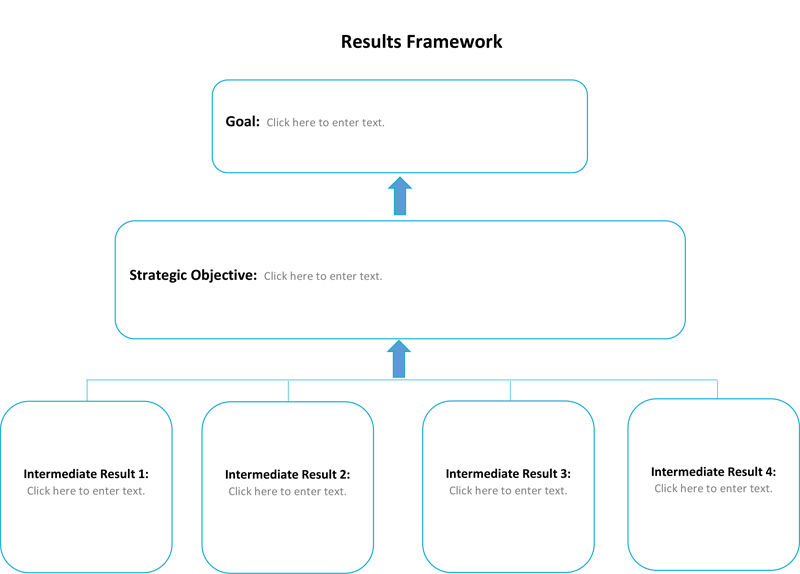Technical Approach
The technical proposal is the crux of the entire grant or proposal. It should tell the funder exactly how your organization will achieve the project’s overall goals.
Every technical proposal should begin with a Results Framework as depicted below:
The results framework comes directly from the solicitation released by the funder or investor. Your organization should already have a draft of the framework based on the analysis of the procurement.
Once your organization develops the results framework, it is then possible to develop a technical strategy. The Technical Strategy should describe what your organization will do to reach the program’s goal, strategic objective and results. The strategy can be stated in one to four sentences and should take into consideration the country and/or regional context.
Characteristics of a technical strategy include:
- Describes what your organization will do to address specific problems/challenges
- Should be short, realistic and only promise what your organization can deliver
- Identifies the target population and geographic scope
- Includes a vision statement that describes what your organization sees this project achieving at the end of the implementation period
Based on the technical strategy, your organization should then develop a technical approach. The Technical Approach provides a broad description of how your organization will achieve the program’s goals. It should also go into detail as to what core activities the program will implement, who the program will collaborate with, when each core activity will occur, where the program will work and what populations the core activities will target.
The approach may include a conceptual framework or graphic demonstrating the program’s core activities and any cross cutting technical areas of work that will be implemented. The approach should then be used to inform the workplan, budget, M&E and staffing needs.
Illustrative Technical Strategy and Approach
EXAMPLE: Honduras Unidad Local de Asistencia Técnica (ULAT) Project
With the technical approach completed, an organization can then begin to develop the Detailed Activities for the program. These activities should describe how each of the core activities (or the approach) will be implemented. The activities should include the following type of information:
- What is to be done?
- Who will do it?
- Where will it be done?
- When will it be done?
- What is the objective of this activity?
- Who will participate (target audience)?
- What partners will be involved and in what way (if applicable)?
- What tools/resources will you use or need to develop?
- How does this activity promote the project results?
- How much will it cost? (this will be useful for budget)
Like monitoring and evaluation indicators (which we will cover in the next section), the proposal activities should be written in a SMART way. Below is a table describing the criteria for describing a SMART activity.
| Criterion | Description | |
|---|---|---|
| S | Specific | It is clearly written and understood. The desired result is specific enough to be measured by a frequency, percentage, or number. |
| M | Measurable | It is possible to monitor progress and evaluate results. The desired result is framed in terms that are measurable. |
| A | Appropriate | The desired result is appropriate to the scope of your work and the mission of your organization. |
| R | Realistic | The desired result is achievable and within the control of your organization. It can be realistically achieved using the resources available and within the timeframe of your implementation plan. |
| T | Time-bound | There is a specific time period for achieving the desired result. |


